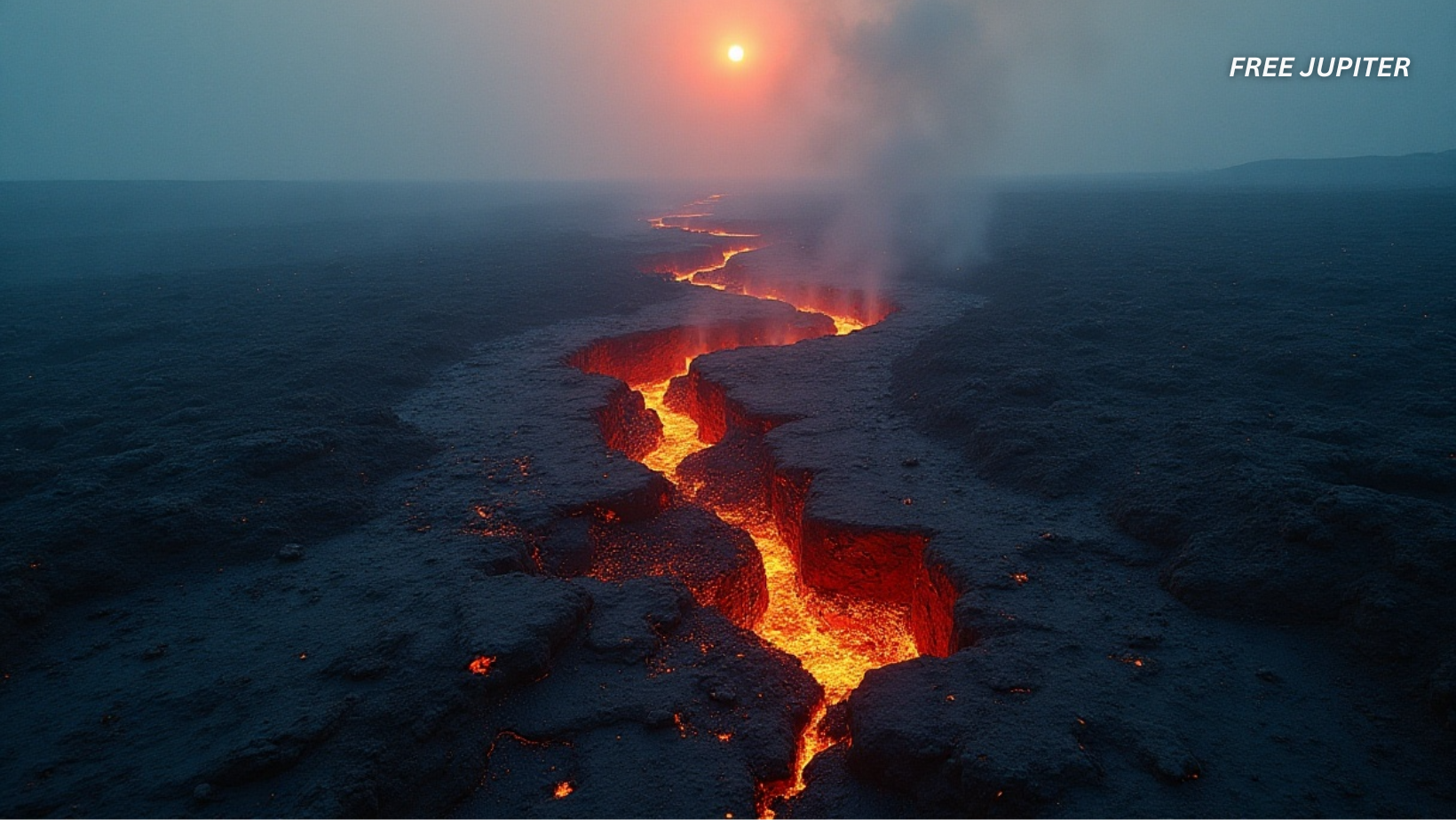Friendly Note: FreeJupiter.com shares general info for curious minds 🌟 Please fact-check all claims—and always check health matters with a professional 💙
Rising like a stone carved skyline above the clouds, the Himalayas have long stood as the colossal testament to Earth’s tectonic tug of war. For over 60 million years, these peaks have been born out of an epic geological handshake — or perhaps more accurately, a sustained collision — between the Indian and Eurasian plates. But while the grandeur of these mountains is plain to see, what’s unfolding beneath them is far stranger and more fractured than previously imagined.
Geologists now believe that India, geologically speaking, is not just pushing northward into Asia. It’s also cracking apart deep underground. And not just cracking, but splitting. A new wave of seismic data, paired with gas emissions from mineral springs, suggests something astonishing: a section of the Indian tectonic plate might be peeling in two.
The Hidden Theater of Plate Tectonics
Tectonic plates aren’t monolithic slabs. They’re complex, layered entities composed of lighter crust and denser upper mantle materials. Continental plates like India’s are especially stubborn when it comes to subduction. Slipping beneath another plate and diving into Earth’s mantle. Unlike their oceanic counterparts, which tend to go under with relative ease, continental plates usually crumple and resist the plunge.
So how does a landmass as large as India get shoved under the roof of the world?
Previously, scientists imagined two possible answers: either the Indian Plate is sliding in a near horizontal fashion beneath Tibet, refusing to dip deeper, or its buoyant upper section is buckling while the denser base slips below. Both scenarios offered partial clues, but they didn’t explain everything.
A fresh study, led by geoscientists and presented at the American Geophysical Union conference, is now reshaping that narrative. The new data implies a third, more dramatic possibility: delamination. Essentially, this is a geological version of a layered cake coming apart, where the bottom layer (the dense part of the plate) is peeling away and sinking, while the top stays put. To make things even more intriguing, researchers believe there’s a vertical tear forming where this geological shearing is taking place.
A Continental Plate Literally Tearing Apart
Douwe van Hinsbergen, a geodynamicist from Utrecht University, expressed astonishment at the implications. “We didn’t know continents could do this,” he said. That single insight alone challenges existing ideas in Earth science.
The tear, if confirmed, could reshape our understanding of how mountain ranges like the Himalayas are formed — not just by collision, but by internal fragmentation. The research is still in its early stages, but it’s already sending tremors through the scientific community.
However, as with all things geological, there’s a caveat. Fabio Capitanio from Monash University warns that these are still early findings. “It’s just a snapshot,” he said, pointing out the limited nature of the current dataset. Yet, even a snapshot in geology, where timelines span millions of years, can offer priceless perspective.
Read more: NASA Finds A Massive Diamond In Space That Is 5 Times Larger Than Earth!
From Computer Models to Real World Proof
The concept of tectonic plates splitting or “unzipping” isn’t entirely new. Theoretically, scientists have long suspected that such internal separations might happen, especially under pressure. But until now, this sort of behavior had mostly lived in computer models or deep beneath stable landmasses.
This new case, however, involves a subducting plate — one that is actively diving beneath another. That’s a first.
The researchers focused their attention on northeastern India, especially the area bordering Bhutan, where the plate boundary takes a sharp turn. Such bends often become hotspots for tectonic drama. Here, the Indian Plate is not only being pushed northward but twisted sideways — a recipe for stress and, potentially, structural failure.
Simon Klemperer, a geophysicist at Stanford University and one of the lead investigators, zeroed in on this turbulent zone. His team spent years measuring gas emissions, particularly helium isotopes, bubbling up from thermal springs scattered across the Tibetan Plateau.
Why helium? Because its isotopes act like geological breadcrumbs. Helium 3, a rare version of the element, is mostly found in the Earth’s mantle, left over from the planet’s birth. Helium 4, in contrast, is created by radioactive decay in the crust. By comparing the two, researchers can tell whether the gases are coming from shallow crustal rock or deeper mantle sources.
Gases That Tell a Story
A curious pattern emerged. Springs south of a particular line all emitted crustal helium, while those to the north carried the unmistakable fingerprint of mantle helium. That line, scientists believe, marks the furthest edge of the intact Indian Plate sliding beneath Tibet.
But here’s where it gets even more curious.
A few springs, found south of that presumed edge, also emitted mantle helium. This unexpected result suggested something odd was happening — perhaps the crust and mantle had parted ways. According to the researchers, it could mean that a chunk of the Indian Plate is not simply being shoved northward; it’s breaking off and sinking, allowing hot mantle material to rise and take its place.
Read more: Jupiter Used To Be Twice As Big — It Could Have Held 2,000 Earths Inside
Imaging the Tear Below Our Feet
To test this idea, the team turned to seismic imaging, essentially Earth’s version of an ultrasound. By tracking the movement of earthquake waves through the planet, scientists can “see” variations in density and structure far beneath the surface.
One seismic profile revealed a pair of distinct, blob-like features beneath Tibet. These shapes hinted at a lower slab of the Indian Plate that had begun detaching from the upper crust. In a follow-up analysis using a different type of wave, researchers spotted what appeared to be a rip running vertically along the western edge of the break.
West of the tear, the Indian Plate looked intact, stretching to a depth of about 200 kilometers. But east of the tear, where the slab had apparently split, the mantle appeared to be intruding upward at shallower depths — around 100 kilometers. This matched the helium data and strengthened the case for delamination.
Ripples Felt at the Surface?
Anne Meltzer, a seismologist at Lehigh University, highlighted the wider relevance of the discovery. “Most continents have experienced major collisions at some point in their history,” she said. By studying these ancient and ongoing processes, scientists can better understand everything from mountain formation to seismic risk.
Klemperer and his colleagues believe this subterranean tear may already be influencing what happens above ground. Directly above the suspected break is the Cona Sangri rift, a fault zone on the Tibetan Plateau. This suggests a potential link between the forces reshaping the Indian Plate and the fractures we see on the surface.
Though no one is yet claiming that this particular tear is triggering earthquakes, it may be creating the right conditions for them. Van Hinsbergen pointed out that such tears can redistribute stress within a tectonic plate, altering how and where tension builds up — an essential factor in predicting seismic activity.
Read more: Earth’s Core Is Literally Leaking Gold – And Scientists Just Found The Location
A Geological Puzzle Still Unfolding
Continental collisions are messy, multilayered, and often leave behind a tangle of scars — some visible, many hidden. Unraveling that history is no easy task. Yet the Himalayas continue to offer a living laboratory where these colossal forces can be studied in real time.
As the research continues, scientists are eager to see whether similar processes might be at work elsewhere in the world. If continents really can peel apart internally during collisions, that opens up a whole new set of questions — not just about India and Tibet, but about the fundamental mechanics of Earth’s crust.
The story of the Indian Plate is far from over. In fact, it might just be getting more interesting. And as the ground shifts beneath our feet, both literally and scientifically, one thing is clear: Earth’s deepest secrets are often hiding in plain sight, written not in mountain peaks, but in the cracks and crevices far below.










